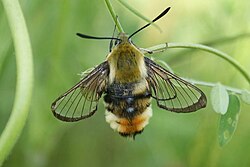| Hemaris | |
|---|---|
 | |
| H. diffinis at Lake Junaluska, U.S. | |
| Scientific classification | |
| Domain: | Eukaryota |
| Kingdom: | Animalia |
| Phylum: | Arthropoda |
| Class: | Insecta |
| Order: | Lepidoptera |
| Family: | Sphingidae |
| Subtribe: | Hemarina |
| Genus: | Hemaris Dalman, 1816 |
| Species | |
See text | |
| Synonyms | |
| |
Hemaris is a genus of sphinx moths in the subfamily Macroglossinae, which is native to the Holarctic. [1] Their main host plants are herbs and shrubs of the teasel and honeysuckle families. Moths in genus Hemaris are known collectively as clearwing moths in the US and Canada and bee hawk-moths in Britain. The related Old World hummingbird hawk-moths, genus Macroglossum , are similar in appearance and habits. Both genera have tails that are provided with an expansile truncated tuft of hairs, [2] but only Hemaris has the disc of the wings transparent, as these scales are dropped soon after eclosion.










